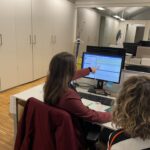Increase internal organisation, meet market needs, improve communication between departments, increase value-added activities carried out by people. It is with these objectives that Bulgari has decided to include the CyberPlan APS solution within its information ecosystem. The well-known company based in Rome has told us about the work done by its people to improve methods and tools used for production planning and scheduling.
Bulgari, a world reference in the luxury sector, based in Rome
Bulgari was founded at the end of 1884 by the founder Sotirios Voulgaris, a jeweller of Greek origin who, with great audacity and great vision, decided to move from Greece to Italy and found what is now recognised as the world’s greatest jeweller.
The need to expand the offer to customers led Bulgari, towards the end of 1900, to extend its production by also adding accessories, which are inspired by the iconic signs of the brand such as the Snakes Forever bag.
The Bulgari accessories category today includes, in addition to bags and small leather goods, also silk and cashmere products. The brand’s product diversification also includes collections of watches and perfumes.
To produce its products, Bulgari has chosen to give priority to its areas of expertise, which is why Florence is the reference point for leather goods with its manufacture, Valenza is the goldsmith’s pole, to which is added the workshop for fine jewellery in Rome, the Como site for the processing of silk and that of Lodi for perfumes.
Careful selection based on clear and specific requirements
The planning of the production of leather goods and accessories in Bulgari was managed through spreadsheets; company ambitions and objectives led the staff of the house to seek improvement solutions that would raise standards, taking them to another level.
Among the fundamental requirements was the integration and perfect insertion of the new tool into the existing ecosystem, formed by advanced solutions in the field of ERP (Enterprise Resource Planning), BI (Business Intelligence) and PLM (Product Lifecycle Management). Bulgari’s IT was already structured but still needed a piece to complete the solid system and a perfect integration with the SAP management system was necessary.
Just as Bulgari craftsmen are put in a position to carry out the value-added part of their work, so planners must also be supported in carrying out their activities with suitable tools that eliminate repetitive activities with low added value such as order openings, now carried out by the APS.
Having carried out the software selection, and identified CyberPlan APS as the best solution, the Bulgari team carried out the project together with Cybertec consultants during the first half of 2020, despite the novelties and difficulties of that historical period, demonstrating strong determination and will. The project was completed extremely quickly but the flexibility of the tool means that it can be constantly developed and adapted around the new needs and objectives of Bulgari. A continuous evolution possible also thanks to the skills of the planning department.
A tool perfectly integrated into the IT environment
The CyberPlan APS software has thus replaced spreadsheets and is now used in perfect dialogue with SAP’s ERP, from which it takes the data to schedule all the production of the finished product. The outputs of the APS software allow you to have visibility into the use of human and machine resources over the long term. At the same time, they allow you to see the time required for raw materials, particularly useful in the case of production with precious or rare materials. CyberPlan then allows you to automate orders to the supplier regarding packaging, independently checking if the materials are available for the requested dates. In addition, with the Bulgari APS you can manage the stock with 12-month projections, thanks to explosions of the entire production plan.
The integration between CyberPlan and the software used also takes place with regard to the PLM tool useful for giving the go-live to production. The APS, in coordination with the PLM software, highlights, thanks to the presence of specific flags and a job of creating SKUs, whether it is possible to open an order or not.
A further CyberPlan integration concerns corporate reporting tools in order to carry out in-depth analysis and use a set of KPIs built from CyberPlan APS results.
The planning and scheduling tool therefore allows Bulgari to manage its own production, intentionally characterised by high segmentation and complexity. CyberPlan meets Bulgari in managing this scenario as it allows to simulate the entire production plan and to leave the planner only corrective changes with high added value. In fact, the APS provides the planner with suggestions that allow them to improve not only the work of the planning department but also that of the production and artisans who work in Bulgari. Sudden requests, for example, can be handled in the best way, reducing the impact on the production department.
A tool that also benefits people, as well as goals
Bulgari Accessori’s local supply chain is supported in low-value activities by CyberPlan, allowing the planner team to focus more on strategic decisions. A further advantage was the improvement of the craftsmen’s work in communicating the worktops and in the availability of the materials necessary to guarantee production on time. Thanks to these improvements, Bulgari observed an increase in the feasibility of the lot of 87%.
The improvement in the planning of purchases and in the use of materials has then led to a reduction in shortages and a reduction in the stock of materials. Thanks to the work of people and the implementation of CyberPlan software, Bulgari benefited from a 34% reduction in warehouse value.
Among the added values brought by CyberPlan, particularly relevant, by the Bulgari planner, were the speed of response, the possibility of simulating production scenarios and the possibility of customising views.






